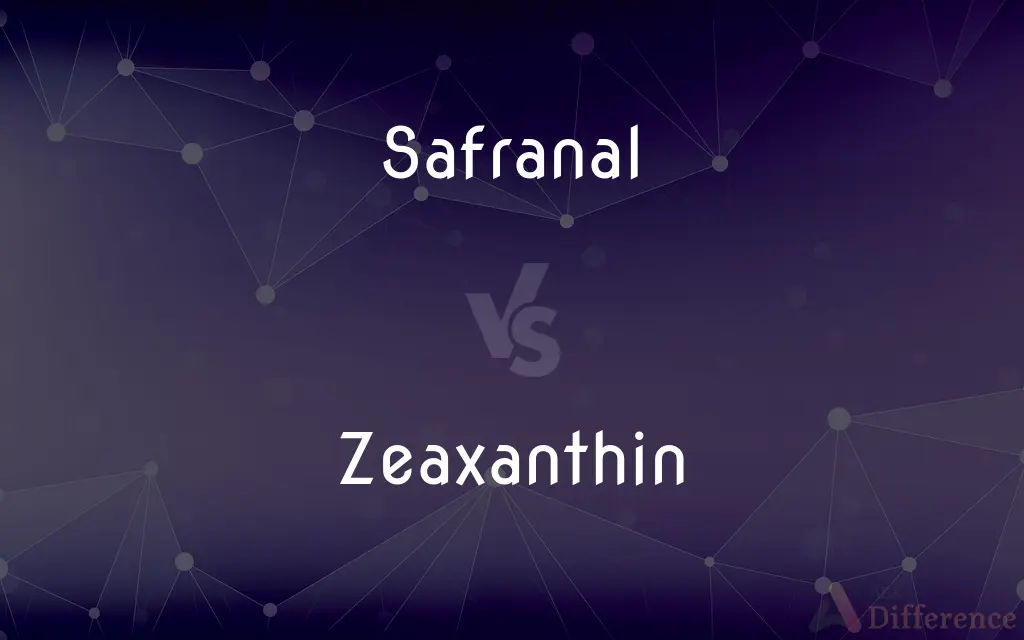Safranal vs. Zeaxanthin — What's the Difference?
Edited by Tayyaba Rehman — By Fiza Rafique — Updated on May 6, 2024
Safranal is a volatile oil primarily responsible for the aroma of saffron, derived from the spice itself, while zeaxanthin is a dietary carotenoid important for eye health, found in various fruits and vegetables.

Difference Between Safranal and Zeaxanthin
Table of Contents
ADVERTISEMENT
Key Differences
Safranal is known for its distinctive aroma, giving saffron its unique fragrance, often used in culinary and perfumery applications. Whereas, zeaxanthin is recognized for its role in maintaining eye health, particularly in protecting against macular degeneration.
Chemically, safranal is a volatile organic compound that is a degradation product of the carotenoid zeaxanthin during the drying process of saffron. On the other hand, zeaxanthin is a stable dietary carotenoid that acts as an antioxidant and is directly linked to eye health benefits.
In terms of sources, safranal is almost exclusively obtained from saffron and is highly prized in both the food industry and traditional medicine. Conversely, zeaxanthin is widely available in several common foods like spinach, kale, and yellow peppers, making it accessible through daily diet.
Safranal's primary uses are in flavoring and aroma-enhancing in foods and cosmetics, reflecting its sensory attributes. Zeaxanthin, however, is primarily utilized for its health benefits, particularly in supplements aimed at enhancing ocular health.
While the extraction and processing of safranal require careful handling of saffron to preserve its aromatic qualities, zeaxanthin is typically extracted on a larger scale from various plant sources for use in food supplements and health products.
ADVERTISEMENT
Comparison Chart
Primary Role
Aromatic compound in saffron.
Carotenoid involved in eye health.
Source
Derived from saffron.
Found in fruits and vegetables like kale and peppers.
Chemical Nature
Volatile organic compound, degradation product of zeaxanthin.
Stable dietary carotenoid, antioxidant.
Main Uses
Used in perfumery and flavoring.
Used in dietary supplements for eye health.
Health Benefits
Used in traditional medicine for its aroma.
Protects against macular degeneration, antioxidant properties.
Compare with Definitions
Safranal
A compound used in aromatherapy and perfumery.
The perfume featured a note of safranal derived from saffron.
Zeaxanthin
A carotenoid that contributes to eye health.
Zeaxanthin is important for maintaining good vision.
Safranal
A volatile oil contributing to saffron's aroma.
Safranal's distinct smell enhances the flavor of the paella.
Zeaxanthin
Commonly combined with other carotenoids in health products.
Lutein and zeaxanthin are often combined in vision health supplements.
Safranal
Found in saffron, used for its sedative properties in traditional medicine.
Safranal is utilized in herbal teas for its calming effects.
Zeaxanthin
Found in high concentrations in leafy greens and certain vegetables.
Adding kale to your diet increases zeaxanthin intake.
Safranal
Used in culinary applications for its fragrance.
Safranal is responsible for the distinctive aroma of some traditional dishes.
Zeaxanthin
Used in dietary supplements for its antioxidant properties.
He takes a zeaxanthin supplement to support his eyesight.
Safranal
A byproduct of the carotenoid zeaxanthin in saffron.
Through the drying process, zeaxanthin degrades into safranal.
Zeaxanthin
Protects the eyes from harmful UV and blue light.
Zeaxanthin filters out harmful rays, protecting the retina.
Safranal
Safranal is an organic compound isolated from saffron, the spice consisting of the stigmas of crocus flowers (Crocus sativus). It is the constituent primarily responsible for the aroma of saffron.
Zeaxanthin
Zeaxanthin is one of the most common carotenoids in nature, and is used in the xanthophyll cycle. Synthesized in plants and some micro-organisms, it is the pigment that gives paprika (made from bell peppers), corn, saffron, wolfberries, and many other plants and microbes their characteristic color.The name (pronounced zee-uh-zan'-thin) is derived from Zea mays (common yellow maize corn, in which zeaxanthin provides the primary yellow pigment), plus xanthos, the Greek word for "yellow" (see xanthophyll).
Safranal
(organic compound) An organic compound isolated from saffron, believed to be a degradation product of the carotenoid zeaxanthin via the intermediacy of picrocrocin.
Zeaxanthin
A yellow xanthophyll carotenoid, C40H56O2, that is found in yellow corn and in the leaves of many plants, in egg yolk, and in the retina, and that may help to prevent macular degeneration.
Zeaxanthin
(organic compound) A yellow crystalline carotenoid alcohol that occurs widely with lutein, with which it is isomeric, and is the chief pigment of maize
Zeaxanthin
Yellow carotenoid (isomeric with lutein and occurs widely with it) that is the main pigment in yellow indian corn
Common Curiosities
What is safranal?
Safranal is a volatile oil from saffron known for its aroma and used in flavoring and perfumery.
What are the main uses of safranal in industries?
Safranal is used in the food and cosmetic industries for its aromatic properties.
How are safranal and zeaxanthin related chemically?
Safranal is a degradation product of zeaxanthin in the saffron drying process.
Where can zeaxanthin be found naturally?
Zeaxanthin is found in vegetables and fruits like spinach, kale, and yellow peppers.
How does zeaxanthin benefit eye health?
It acts as an antioxidant and filters harmful light, reducing the risk of macular degeneration.
Is zeaxanthin available in supplement form?
Yes, zeaxanthin is widely available in dietary supplements, especially for eye health.
Can safranal be synthesized?
Safranal can be synthesized, but it is most commonly extracted directly from saffron.
Is safranal used in any medical treatments?
While not a standard medical treatment, safranal is researched for its potential therapeutic effects in neurology and oncology.
What is zeaxanthin and its primary benefit?
Zeaxanthin is a carotenoid important for protecting the eyes from age-related degeneration and maintaining overall eye health.
What role does zeaxanthin play in protecting against blue light?
Zeaxanthin helps filter blue light, which is important to protect the retina and maintain long-term vision health.
What distinguishes safranal's use in traditional medicine?
Traditionally, safranal has been used for its potential sedative and antidepressant properties.
How does dietary intake of zeaxanthin affect health?
Regular intake of zeaxanthin through diet is linked to improved eye health and reduced risk of chronic diseases due to its antioxidant properties.
Can the aroma of safranal be beneficial?
The aroma of safranal is considered beneficial in aromatherapy for reducing stress and improving mood.
What are the environmental sources of zeaxanthin?
Zeaxanthin is primarily sourced from green leafy vegetables, certain fruits, and some grains.
How is safranal extracted from saffron?
Safranal is extracted during the drying process of saffron and can be further isolated using various chemical techniques.
Share Your Discovery

Previous Comparison
Wiki vs. Wikipedia
Next Comparison
Romper vs. OverallsAuthor Spotlight
Written by
Fiza RafiqueFiza Rafique is a skilled content writer at AskDifference.com, where she meticulously refines and enhances written pieces. Drawing from her vast editorial expertise, Fiza ensures clarity, accuracy, and precision in every article. Passionate about language, she continually seeks to elevate the quality of content for readers worldwide.
Edited by
Tayyaba RehmanTayyaba Rehman is a distinguished writer, currently serving as a primary contributor to askdifference.com. As a researcher in semantics and etymology, Tayyaba's passion for the complexity of languages and their distinctions has found a perfect home on the platform. Tayyaba delves into the intricacies of language, distinguishing between commonly confused words and phrases, thereby providing clarity for readers worldwide.
















































